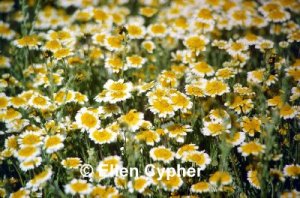Endangered Species Recovery Program | |
|
Home | News | Publications | Species profiles | Data and maps | About | Staff | Links | Department of Biological Sciences | CSU Stanislaus |

Munz's tidy-tips
Layia munzii
Status
None federal or state. California Native Plant Society List 1B.
Life History
Munz's tidy-tips is an annual that flowers during March and April. Cross-pollination is required for seed set. Other facets of the life history have not been studied. Munz's tidy-tips grows on alkaline clay in low-lying scrublands and on hillsides in grasslands. Associated species may include red brome (Bromus madritensis ssp. rubens), annual fescue (Vulpia microstachys), Lost Hills saltbush (Atriplex vallicola) [CL], common tidy-tips (Layia platyglossa), iodine bush (Allenrolfea occidentalis), and spiny saltbush (Atriplex spinifera). Historical occurrences ranged from 45 to 800 m in elevation.
The stems of Munz's tidy-tips may trail along the ground or grow upright. The lower leaves are lobed. Flowers are borne in heads. The ray florets are yellow with white tips, whereas the disk florets are yellow. The two types of florets produce achenes (single-seeded fruits) that differ somewhat in form.
Distribution
Historically, Munz's tidy-tips was widespread in the western San Joaquin Valley and inner Coast Ranges. Specimens were collected in Fresno, Kern, and San Luis Obispo counties. Few of the historical populations of this species have been confirmed in the past 50 years, but most low-lying areas in the historic range have been converted to agriculture during that time. Munz's tidy-tips is believed to remain extant near Soda Lake in San Luis Obispo County and in the vicinity of Lost Hills in Kern County.
Classification
Subclass ASTERIDAE, Order ASTERALES, Family ASTERACEAE, Genus Layia, Species munzii
Subspecies
None.
Recent Synonyms
None.
Other Common Names
None.
References
Skinner, M.W., and B.M. Pavlik, eds. 1994. Inventory of rare and endangered vascular plants of California. Fifth edition. Spec. Publ. No. 1, California Native Plant Society, Sacramento, 338 pp.; Hoover, R.F. 1970. The vascular plants of San Luis Obispo County, California. University of California Press, Berkeley, 350 pp.; Twisselmann, E.C. 1967. A flora of Kern County, California. University of San Francisco, San Francisco, CA, 395 pp.; Baldwin, B., and S.J. Bainbridge. 1993. Layia. Pp. 300-303 in The Jepson manual: higher plants of California (J.C. Hickman, ed.). University of California Press, Berkeley, 1400 pp.; Keck, D.D. 1935. Studies upon the taxonomy of the Madinae. Madroño 3:4-18; Rarefind, California Natural Diversity Data Base, Sacramento.
Size
Height:
1-50 cm
Flower head:
< 3 cm across
Fruit:
2-3.5 mm
Identification
Munz's tidy-tips closely resembles the common tidy-tips and the rare Jones' tidy-tips (L. jonesii). These three species are distinguished by subtle characteristics of the flower heads and achenes. Also, Jones' tidy-tips has purple streaks on the stem, unlike Munz's tidy-tips. Munz's tidy-tips can be distinguished from Comanche Point layia [CL] by the color of the ray florets.
Authors of Profile
E.A. Cypher